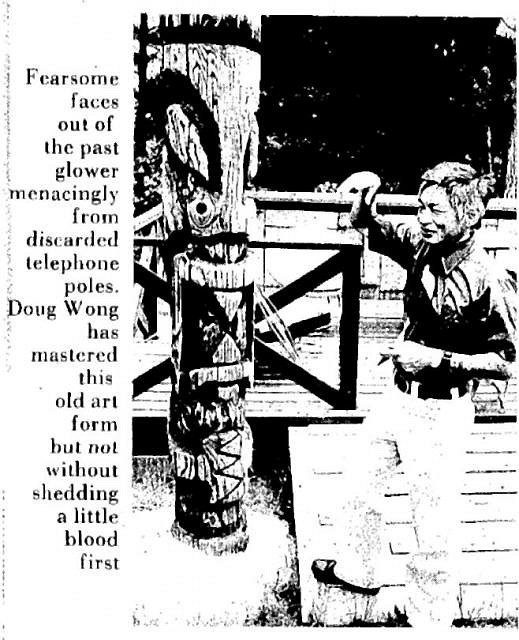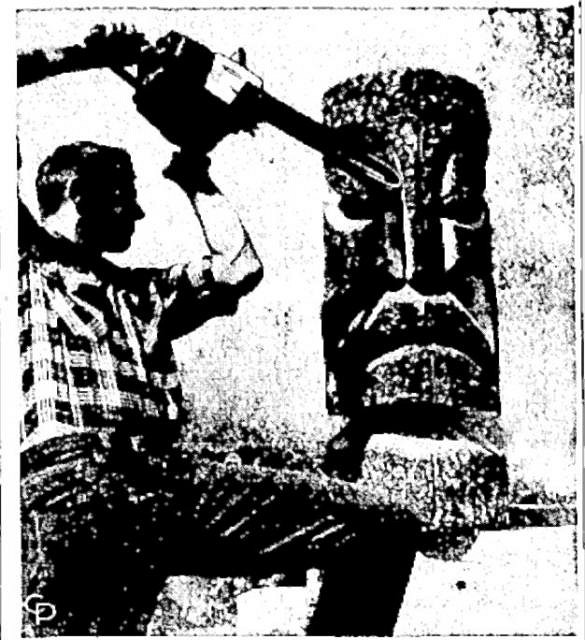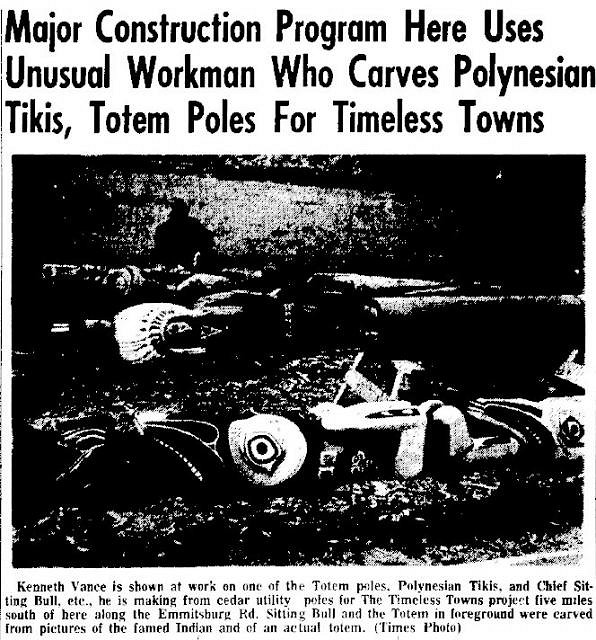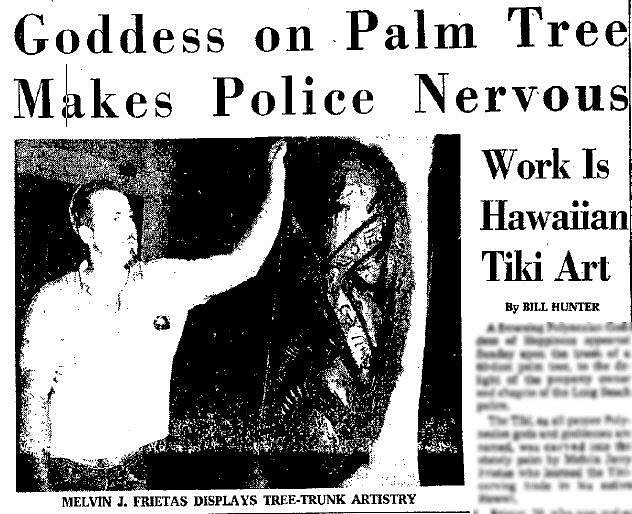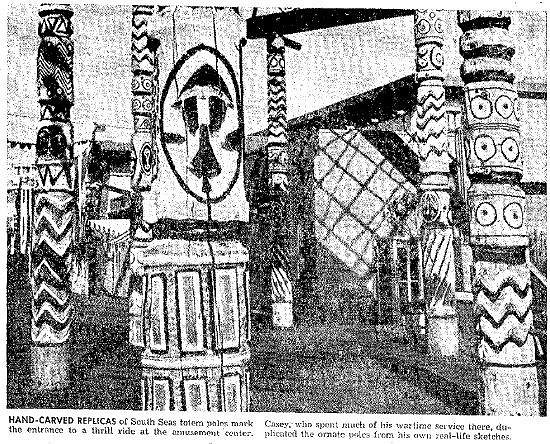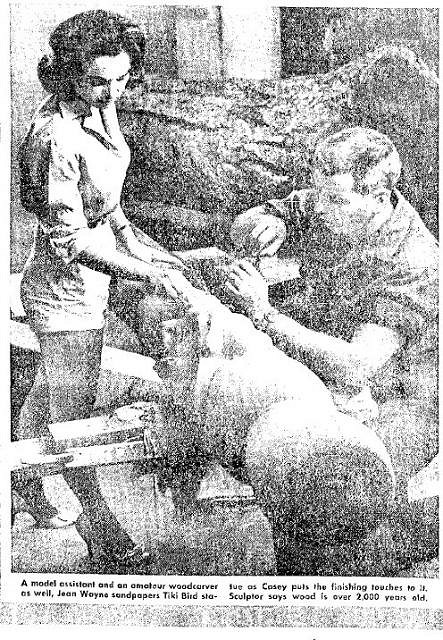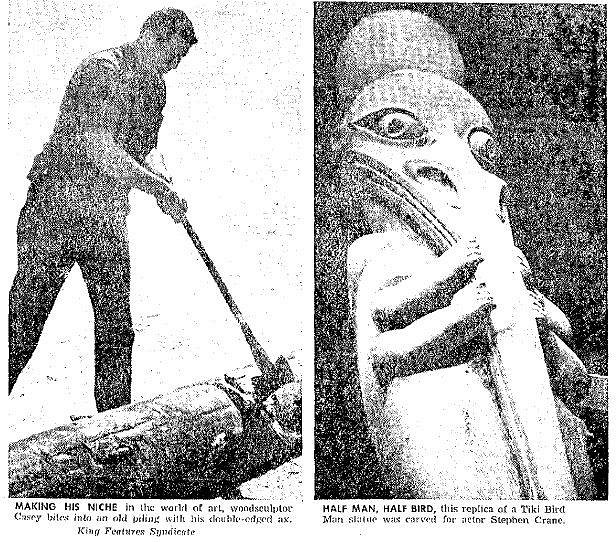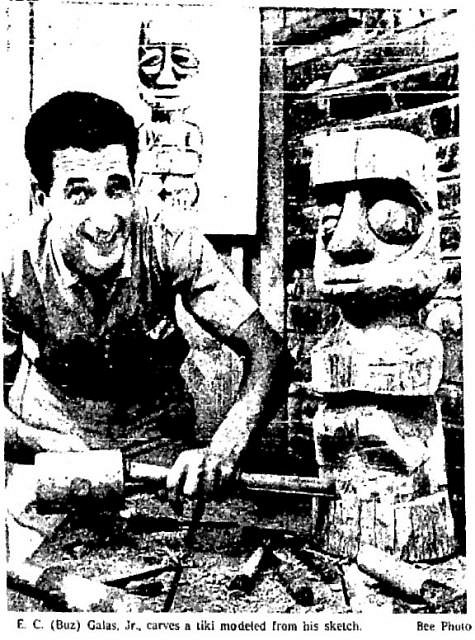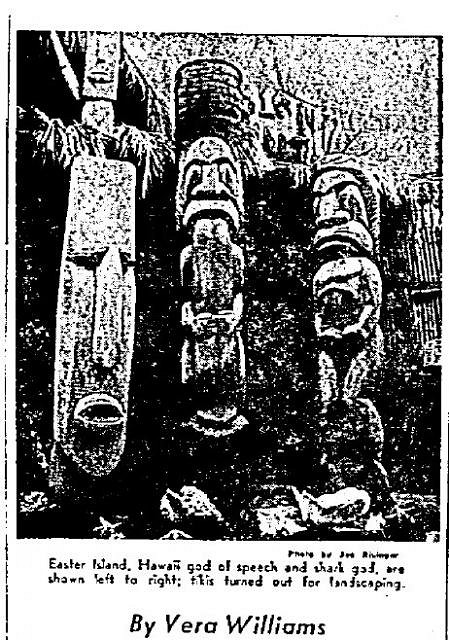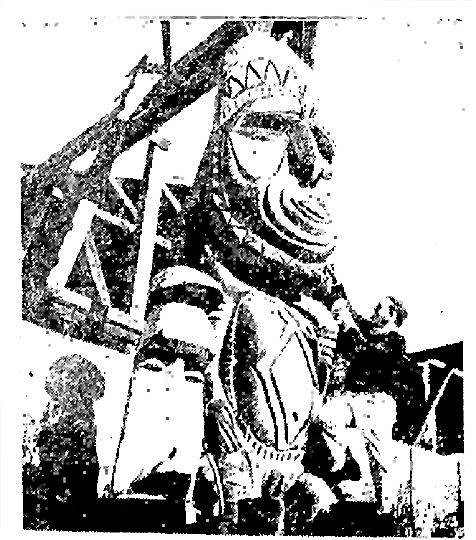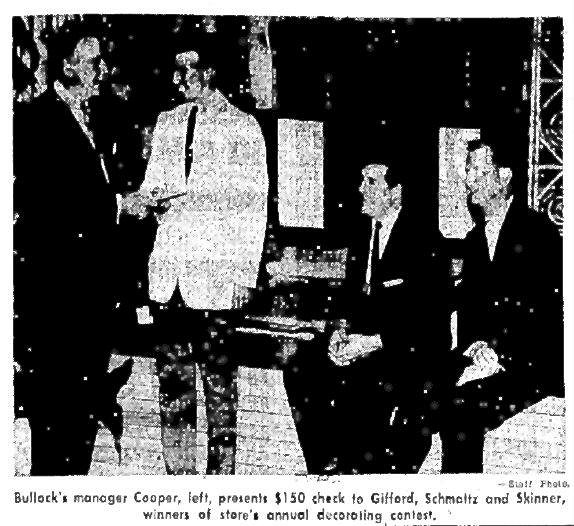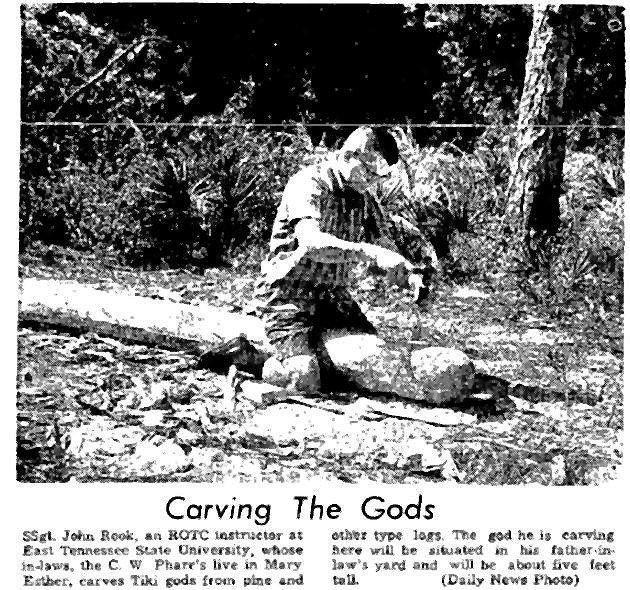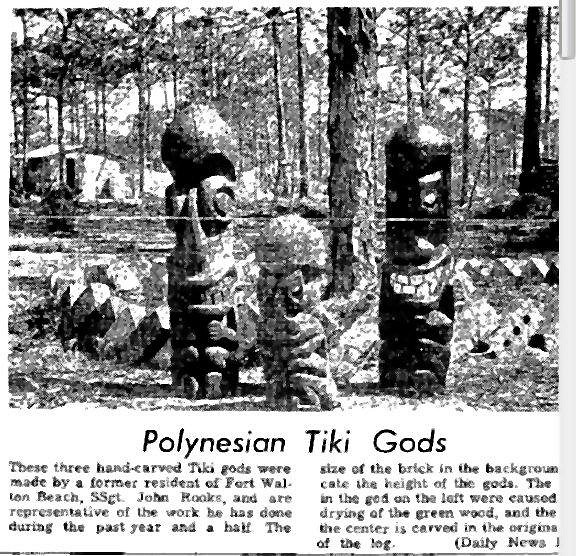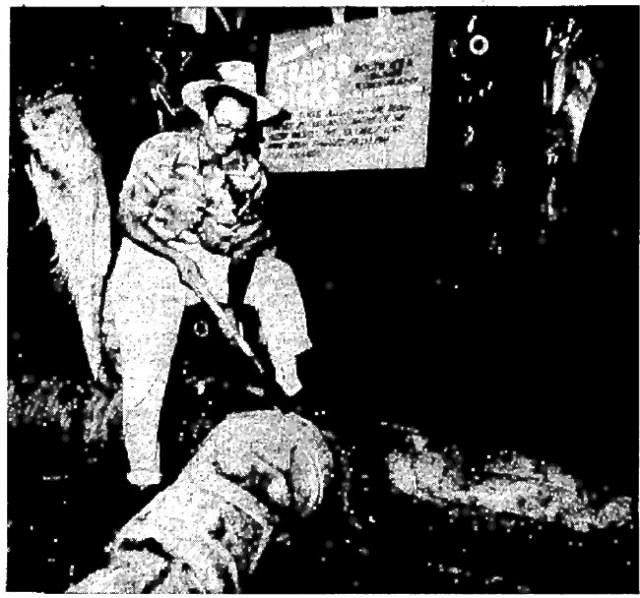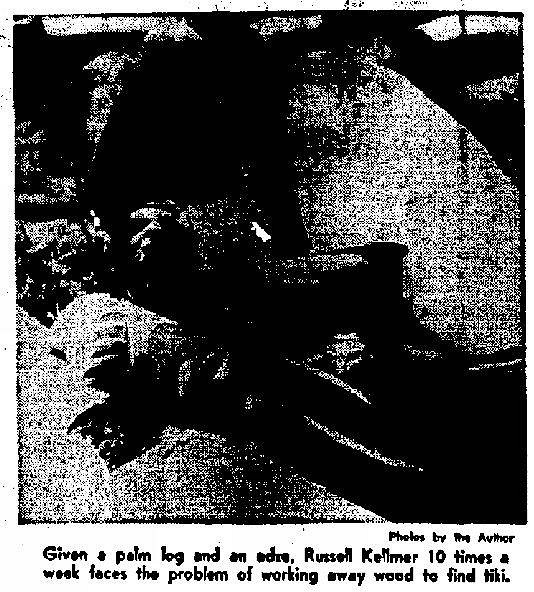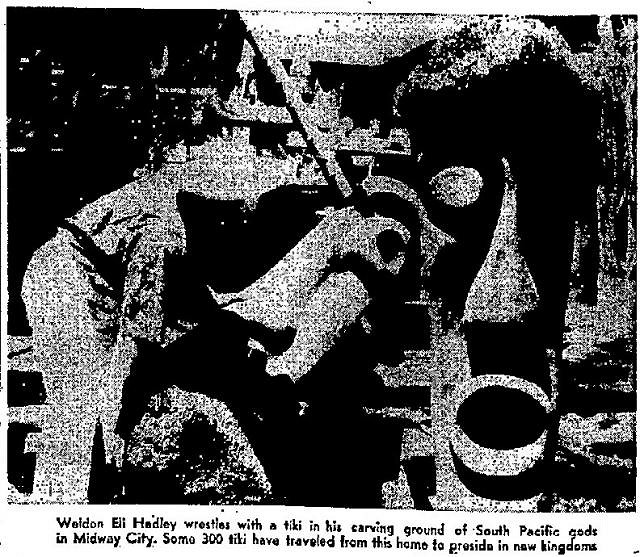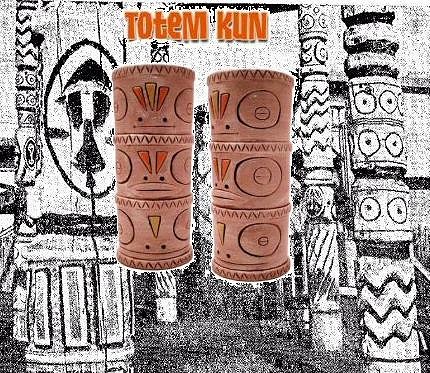Tiki Central / Tiki Carving
Tiki Heroes & Carvers of Yore
Pages: 1 36 replies
|
P
pappythesailor
Posted
posted
on
Thu, Aug 2, 2007 7:25 PM
I've been doing some Internet research lately. I never find what I want but I often find stuff worth keeping. I found enough articles on past tiki heroes to flesh out a new topic. I hope you see where I'm going with this. Let's start with everyone's favorite relative of Bamboo Ben (right after the lovely Auntie Bungy) Eli Hedley! (From the Nevada State Journal 18 February 1973) Around the TownMany who have paid a visit to Trader Dick's new home an the casino addition to John Ascuaga's NUGGET have |
|
P
pappythesailor
Posted
posted
on
Thu, Aug 2, 2007 7:35 PM
And onto maybe a forgotten Tiki carver, Doug Wong. (Anyone know Doug?) (From the Billings Gazette 21 November 1976)
CAMBRIDGE, Md, — The Polynesians carve tiki poles The pole also should be at least one to two feet thick, according |
|
P
pappythesailor
Posted
posted
on
Thu, Aug 2, 2007 7:40 PM
Then there's Oregon's Mike McVay. Anybody know Mike????? (from the Bridgeport Telegram 14 January 1966)
INSTANT ANCIENT ART —Oregon artist Mike McVay |
|
P
pappythesailor
Posted
posted
on
Thu, Aug 2, 2007 7:52 PM
How about Kenneth Vance of Pennsylvania? (from the Gettysburg Times 26 August 1972)
...Vance's creations are designed to project the Polynesian and American influence. |
|
P
pappythesailor
Posted
posted
on
Thu, Aug 2, 2007 8:05 PM
and maybe one you were scared by Melvin J Freitas' work as a youngster. Who's in Long Beach? Is his tiki face still there? (from the Long Beach Independent 13 November 1961)
A frowning Polynesian Goddess |
|
P
pappythesailor
Posted
posted
on
Thu, Aug 2, 2007 8:09 PM
YAWN More tomorrow unless I get complaints. |
|
K
kingstiedye
Posted
posted
on
Thu, Aug 2, 2007 8:30 PM
no complaints here pappy. i'm enjoying these posts. mahalo brah. |
|
H
hewey
Posted
posted
on
Thu, Aug 2, 2007 9:29 PM
More dude! :D |
|
T
Tamapoutini
Posted
posted
on
Thu, Aug 2, 2007 9:58 PM
Very interesting and much appreciated. T :) |
|
TGT

The Granite Tiki
Posted
posted
on
Thu, Aug 2, 2007 10:54 PM
I love Pappy's Research threads! Keep'em comin'! |
|
TD
Tiki Diablo
Posted
posted
on
Thu, Aug 2, 2007 11:31 PM
Barnacle Bill from redondo beach? |
|
G
GROG
Posted
posted
on
Thu, Aug 2, 2007 11:40 PM
Excellent thread!!!! |
|
T
Tiki-Kate
Posted
posted
on
Fri, Aug 3, 2007 5:05 AM
Most excellent. Thank you. More please. |
|
J
JohnnyP
Posted
posted
on
Fri, Aug 3, 2007 7:00 AM
Sweeet. Love the article on the goddess carving that makes police nervous, a view to times gone by. |
|
B
Benzart
Posted
posted
on
Fri, Aug 3, 2007 7:25 AM
I agree, Keep'em Coming! |
|
T
TravelingJones
Posted
posted
on
Fri, Aug 3, 2007 10:09 AM
:D SsweeetT Pappy...keep'em coming! :D sniff...sniff...hhhmmm, me sense bigbrotiki nearby...? |
|
P
pappythesailor
Posted
posted
on
Fri, Aug 3, 2007 6:14 PM
Who's seen the work of James B. Casey of California at Pacific Ocean Park or one of Steve Crane's restaurants? (from the Helena Independent Record 15 July 1960)
CASEY AT THE AX Sculptor Finds Outlet |
|
P
pappythesailor
Posted
posted
on
Fri, Aug 3, 2007 6:28 PM
Surely an artiste like Mr. E. C. "Buz" Galas deserves not to be forgotten. (from the Modesto Bee and News Herald 11 July 1962)
Modesto Artist's Motto is: Art For The Love Of Art E. C. (Buz) Galas, |
|
P
Paipo
Posted
posted
on
Fri, Aug 3, 2007 6:36 PM
This is great stuff - a bit of a shame the pics are so grainy but that's to be expected. Here's hoping a few urban archaeologists out there can follow up some of these leads. |
|
T
tikicleen
Posted
posted
on
Fri, Aug 3, 2007 6:44 PM
how did you ever find the photo/article on the hobby tiki artist in modesto? wow! looks like i have a new mission. chehalem drive is directly across the street from the high school i worked at last school year. i doubt good ol' buz still lives there, and i realize his tiki was stolen out of his front yard in '62, but it's still worth a looksee. thanks pappy! |
|
P
pappythesailor
Posted
posted
on
Sun, Aug 5, 2007 9:09 AM
I admit, Willis Harman may not be a tiki hero of yore but he sold cool tikis. (from the Long Beach Indepndent Press Telegram 5 May 1963)
TIKIS ARE IN TOWN VISITORS to 3636 E. Ana- |
|
P
pappythesailor
Posted
posted
on
Sun, Aug 5, 2007 9:15 AM
Salem (Ohio) News (1965-12-07)
—Sculpter Barney West carves wooden Polynesian Tikis in his front yard here and he guarantees them for a century. Here's Barney West hard at work. California did seem to have the market cornered on Tiki then as now. sigh (from the News Tribune, Pierce, Fla., 17 February 1964)
MELANESIAN MARK - =============================================================== Barney West Says He'll Get New Saw [ Edited by pappythesailor on 2024-07-26 09:47:13 ] [ Edited by pappythesailor on 2024-07-26 09:48:23 ] [ Edited by pappythesailor on 2024-07-26 09:54:56 ] |
|
P
pappythesailor
Posted
posted
on
Sun, Aug 5, 2007 9:20 AM
Here's future Tiki Hero, Leroy Schmaltz (of OCeanic Arts fame) and friends winning an award for decorating or something... (from the Pasadena Independent 15 April 1960)
Bullock's Contest |
|
P
pappythesailor
Posted
posted
on
Sun, Aug 5, 2007 9:31 AM
California didn't have every tiki carver. Here's SSgt. John Rook from Tenn. (from the Playground Daily News, Ft. Walton Beach, Fla., 28 March 1967)
Carving Polynesian Tiki Gods Is Unusual Hobby For Sergeant By Cherrie Hopkins |
|
P
pappythesailor
Posted
posted
on
Sun, Aug 5, 2007 9:34 AM
I think I got a couple more Eli Hedley stories, then I'm dry. Please feel free to add your own heroes. Somebody write a newspaper story about Benzart! |
|
TK
Tiki Kaimuki
Posted
posted
on
Sun, Aug 5, 2007 12:11 PM
Thanks for passing on this information to all of us, Pappy. I agree, a full newspaper article on Benzart would seem in order. |
|
P
pappythesailor
Posted
posted
on
Mon, Aug 6, 2007 5:29 PM
Here's the last of 'em. Anybody seen "Milano"? He must have been huge to only have one name. Like Charro or Ann-Margaret. (from the Reno Evening Gazette 26 August 1958)
MILANO, a native of the South Pacific, is shown hand carving "tikis" or native gods as dec- |
|
P
pappythesailor
Posted
posted
on
Mon, Aug 6, 2007 5:45 PM
More about Eli Hedley and some about Russell Kellmer Sorry about the pics. They couldn't be much worse. I even tried to clean them up a little. (from the Long Beach Independent Press Telegram 22 January 1961)
Miday City's Tribe of Gods A SET of grotesque black |
|
TK
Tiki Kaimuki
Posted
posted
on
Mon, Aug 6, 2007 5:49 PM
I wonder if "Milano" was actually Milan Guanko? |
|
P
Polynesiac
Posted
posted
on
Mon, Aug 6, 2007 5:59 PM
Great posts pappy!!! I love the stories! (ya got any on Trader Luke from 'Pedro?) That "Milano" guy looks a little like Milan Guanko and he did the carvings for trader dick's, so I would guess that that is him! Here's a link to a review of Trader Dicks: Keep 'em coming pappy!!!! |
|
P
Paipo
Posted
posted
on
Mon, Aug 6, 2007 6:12 PM
You beat me to it , but you're right (both of you), there's a pic of "Milano"/Milan Guanko on page 249 of the BoT.
To me this perfectly sums up the spirit of creating tiki. |
|
BK

Basement Kahuna
Posted
posted
on
Fri, Aug 17, 2007 3:26 PM
Great post, Pappy. A largely untold story that needs to be! Sven scratched the surface a good bit in the Book Of Tiki, but one could probably fill up a book in entirety with the golden age carvers. Ed Crissman is one of my personal faves, lord rest his crazy soul. These guys all deserve a place...they're why this is all here. |
|
T
teaKEY
Posted
posted
on
Fri, Aug 17, 2007 4:20 PM
anyone ever notice this connection -teaKEY |
|
J
J.S.G.
Posted
posted
on
Fri, Aug 17, 2007 4:41 PM
a sweet post, indeed. hey pappy, I know McVay and wrote about him awhile back on here. Also, he is featured in my book art of chainsaw carving. he is still kickin, carving, in fact he wrote an article for a newsletter I started awhile back, the cutting edge... , it's a recent article, a tiki in seven easy pieces... you can check it out here... http://www.theccsg.com/newsletters/VolumeXIIIissueII.pdf [ Edited by: J.S.G. 2007-08-17 17:07 ] |
|
R
Robin
Posted
posted
on
Wed, Sep 5, 2007 4:44 PM
Sorry I put this message in the wrong place, so I deleted the entire message. Message on collecting Tiki. Enjoyed reading this though! [ Edited by: Robin 2007-09-06 10:21 ] |
|
B
Bowana
Posted
posted
on
Thu, Sep 6, 2007 8:21 PM
I love this thread. Thanks for the history lessons, Pappy. Can't wait for the nexrt chapter! |
|
S
seeksurf
Posted
posted
on
Fri, Sep 28, 2007 8:26 PM
Good stuff Pappy thanks for the read. |
Pages: 1 36 replies

